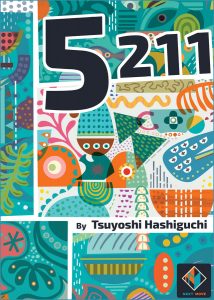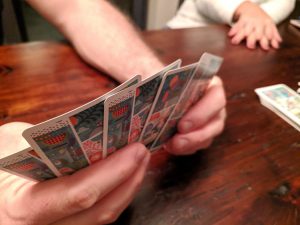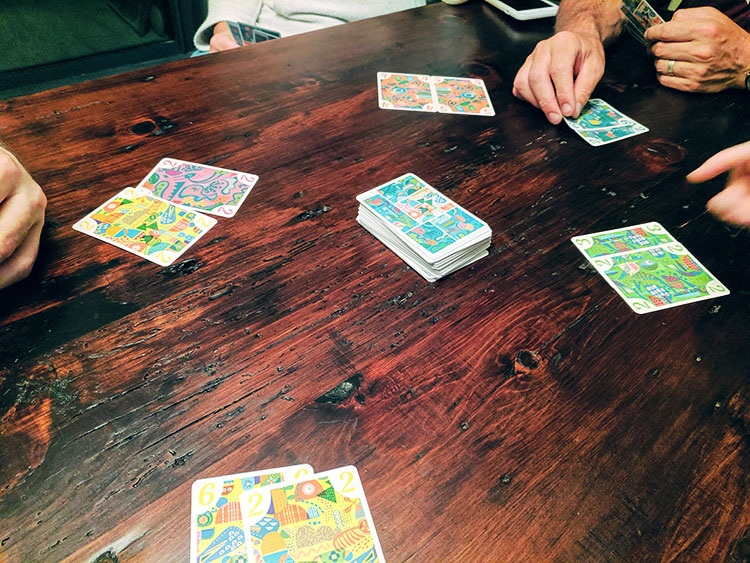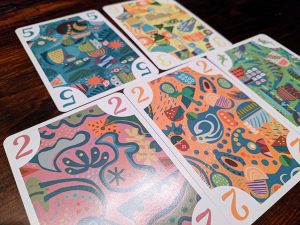 I really enjoy small abstract games that can get a bit thinky if played with the right people. Onirim, Tak, and Nox comes to mind as easily taught and deceivingly tactical games that can scratch the brain burner itch on a coffee table or an airplane tray table (whenever those are accessible again). When 5211 crossed the BGQ radar at GenCon 2019 with its fun art and small footprint, I knew I needed to find out if this too can be in the arsenal of deceivingly tactical small-sized abstract games.
I really enjoy small abstract games that can get a bit thinky if played with the right people. Onirim, Tak, and Nox comes to mind as easily taught and deceivingly tactical games that can scratch the brain burner itch on a coffee table or an airplane tray table (whenever those are accessible again). When 5211 crossed the BGQ radar at GenCon 2019 with its fun art and small footprint, I knew I needed to find out if this too can be in the arsenal of deceivingly tactical small-sized abstract games.
5211 is a hand management/set collection card game for 2 to 5 players that plays best with 3 to 4. It takes about 25 minutes to play.
Gameplay Overview:
In 5211 there are five color suits (20 cards each) with values ranging from 1 to 6. The object of the game is to collect the highest sum of cards in your score pile. The name of the game outlines how cards are played. Players simultaneously draw 5 cards, then play 2 cards, then 1 more, then 1 final card, and then the last card in the hand is discarded.

While the rest of the game is equally as simple, the rules change a bit depending on the number of players. In a short this-is-only-an-overview summary, at the end of each hand, players only add the most abundant colored suit played between all players. In the event that that suit is tied or too abundant (this changes depending on the number of players), then the next most abundant color suit scores and so forth. Simple enough. Complicating this are the Kodobo cards in each suit. While these count towards the color totals, if there are exactly the right number of kodobos played to the table (again dependent on the number of players), then no colors score and only kodobos are transferred to the score pile.
The game ends at the end of the draw pile and everyone then adds up their score pile that they have accumulated.

Game Experience:
The turns in 5211 go quickly when all the players get a handle on the card and value “limits” for the group size. This rapid fire know-thy-enemy and push-your-luck balance during player actions have a way of turning the wryest of smiles into cries of betrayal and agony in a single card flip. Best of all, after the learning curve, it becomes clear that everyone at the table is suddenly invested.

It’s too easy of a game to dislike and too complex of a strategy to get samey or boring. In my experience, from GenCon gaming junkies to local muggle game nights, everyone I have played this with has really had a blast. The artwork is fun, the rules themselves are simple, and the game is quick. There is nothing like thinking you have it in the bag only to have your plans fouled up by some smugly flipped kodobo card. For us, it hits the sweet spot of filler-or-more.
That isn’t to say it’s all kodobos and roses though. The ruleset is simple enough, but the rulebook leaves a lot to be desired. I have gone so far as to rewrite sections in clearer language to limit downtime for successive plays. And while I am apt to toss this into a go bag for a beach or picnic game, a certain go-big-or-go-home type of gamer might have trouble getting into the spirit of things regardless of the 5211’s potential for depth. It’s certainly a style of play that can tread too closely to random style filler for capital G gamers.
I also found the artwork bright, colorful, and very interesting to inspect during others’ A.P., but it can be a distraction that for some is seen as too busy and suggestive of a Magic Eye induced style headache. That said, I didn’t have this issue and loved the artwork.
Final Thoughts:
5211 has found its way to our table (and go-bag) plenty of times. It doesn’t feel random and relies more on tactics than simple card flips. The randomness versus tactics balances of 5211 is similar to that of an Onirim, with the latter being a far more heady style game. Easy to learn rules, small form factor, and a surprising focus on tactics make this an easy one for me to recommend.
Final Score: 3 Stars – A good game that does a lot right, but may be too small for some.
 Hits:
Hits:
• Easy to learn rules
• Beautiful artwork
• Surprisingly tactical
Misses:
• The rulebook can use some work
• May err too much on the side of filler for some players






















